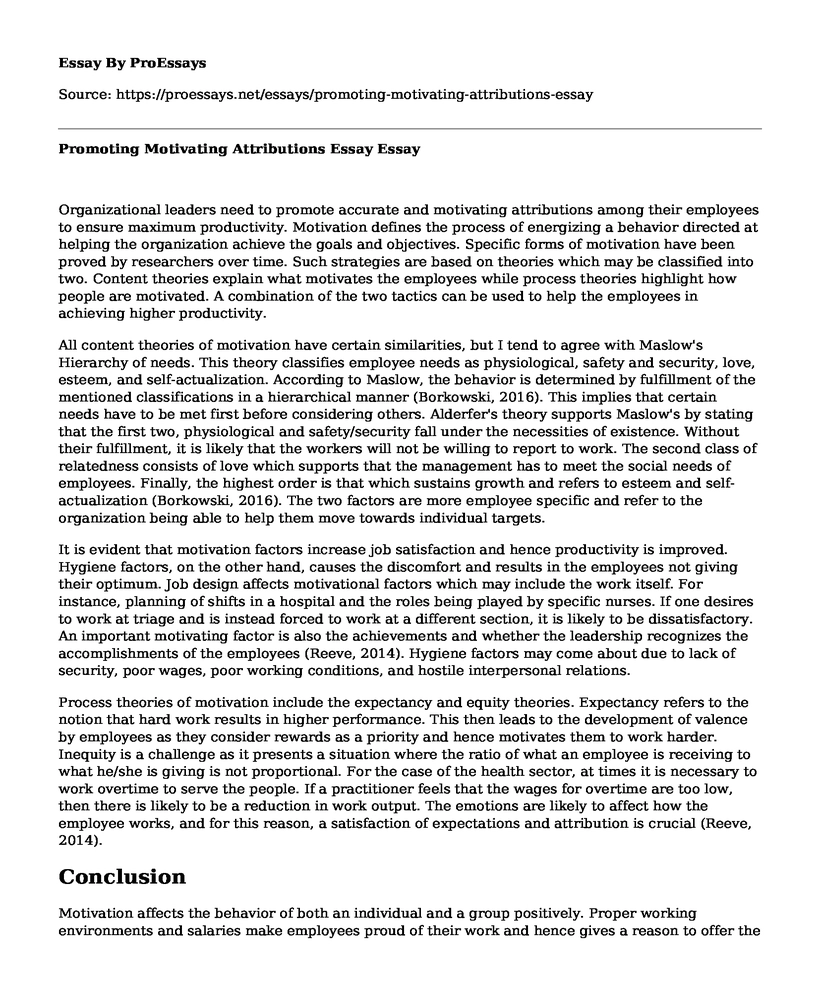Organizational leaders need to promote accurate and motivating attributions among their employees to ensure maximum productivity. Motivation defines the process of energizing a behavior directed at helping the organization achieve the goals and objectives. Specific forms of motivation have been proved by researchers over time. Such strategies are based on theories which may be classified into two. Content theories explain what motivates the employees while process theories highlight how people are motivated. A combination of the two tactics can be used to help the employees in achieving higher productivity.
All content theories of motivation have certain similarities, but I tend to agree with Maslow's Hierarchy of needs. This theory classifies employee needs as physiological, safety and security, love, esteem, and self-actualization. According to Maslow, the behavior is determined by fulfillment of the mentioned classifications in a hierarchical manner (Borkowski, 2016). This implies that certain needs have to be met first before considering others. Alderfer's theory supports Maslow's by stating that the first two, physiological and safety/security fall under the necessities of existence. Without their fulfillment, it is likely that the workers will not be willing to report to work. The second class of relatedness consists of love which supports that the management has to meet the social needs of employees. Finally, the highest order is that which sustains growth and refers to esteem and self-actualization (Borkowski, 2016). The two factors are more employee specific and refer to the organization being able to help them move towards individual targets.
It is evident that motivation factors increase job satisfaction and hence productivity is improved. Hygiene factors, on the other hand, causes the discomfort and results in the employees not giving their optimum. Job design affects motivational factors which may include the work itself. For instance, planning of shifts in a hospital and the roles being played by specific nurses. If one desires to work at triage and is instead forced to work at a different section, it is likely to be dissatisfactory. An important motivating factor is also the achievements and whether the leadership recognizes the accomplishments of the employees (Reeve, 2014). Hygiene factors may come about due to lack of security, poor wages, poor working conditions, and hostile interpersonal relations.
Process theories of motivation include the expectancy and equity theories. Expectancy refers to the notion that hard work results in higher performance. This then leads to the development of valence by employees as they consider rewards as a priority and hence motivates them to work harder. Inequity is a challenge as it presents a situation where the ratio of what an employee is receiving to what he/she is giving is not proportional. For the case of the health sector, at times it is necessary to work overtime to serve the people. If a practitioner feels that the wages for overtime are too low, then there is likely to be a reduction in work output. The emotions are likely to affect how the employee works, and for this reason, a satisfaction of expectations and attribution is crucial (Reeve, 2014).
Conclusion
Motivation affects the behavior of both an individual and a group positively. Proper working environments and salaries make employees proud of their work and hence gives a reason to offer the maximum skills. Motivation serves the purpose of pushing the employees forward by channeling all their energy for a common cause (Borkowski, 2016). In this case, it is evident that the content and process theories are applicable in healthcare. The challenges faced by employees in this sector form part of hygiene factors as mentioned and if addressed, then productivity is set to increase. Conclusively, it is the role of leaders to combine strategies for motivation.
References
Borkowski, N. (2016). Organizational behavior, theory, and design in health care. (3rd Ed.). Boston: Jones & Bartlett Publishers. ISBN 978-1-284-05088-2
Reeve, J. (2014). Understanding motivation and emotion. John Wiley & Sons.
Cite this page
Promoting Motivating Attributions Essay. (2022, May 17). Retrieved from https://proessays.net/essays/promoting-motivating-attributions-essay
If you are the original author of this essay and no longer wish to have it published on the ProEssays website, please click below to request its removal:
- Job Attitude and Organizational Behaviors Essay
- Prevention of Workplace Violence Essay Example
- Personal Beliefs and Values: Nursing Essay Example
- How Group Norms Exert Influence on an Individual's Behavior - Essay Sample
- Paper Example on Starbucks: Success Through CSR
- DMGT Promotes Equality, Diversity, and Inclusion in the Workplace - Essay Sample
- Essay Sample on Automotive Cost Mitigation & Outsourcing







